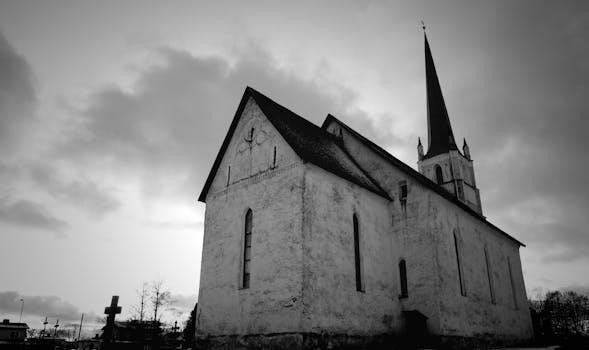Understanding Church Funeral Resolutions
Church funeral resolutions are formal documents honoring the deceased. These resolutions often highlight the individual’s contributions to the church and community, reflecting their life and faith. They serve as a comforting tribute.
What is a Church Funeral Resolution?
A church funeral resolution is a formal statement, often presented during a memorial or funeral service, that recognizes the life and contributions of a deceased member of the church. It’s a document created by the church leadership or a designated committee, expressing the congregation’s collective sentiments of sorrow, appreciation, and respect. These resolutions often include biographical details, highlighting the individual’s service, faith, and positive impact on the church community. They are designed to provide comfort to the bereaved and serve as a lasting tribute to the deceased’s memory. The resolution is typically read aloud during the service and may be presented to the family as a keepsake.

Key Elements of a Funeral Resolution
A funeral resolution typically includes the deceased’s name, church affiliation, and a summary of their life. It also contains concluding remarks offering comfort to the family.
Name of the Deceased and Affiliation
The resolution begins by clearly stating the full name of the deceased, ensuring proper identification and respect. It also notes their church affiliation, highlighting their connection to the faith community. This section establishes the foundation of the tribute, grounding it in the individual’s identity and spiritual life. The inclusion of this information is vital for accurately representing the person being honored, recognizing their place within the church and its members. This detail provides context and helps personalize the document, making it a meaningful expression of remembrance. This also serves as a record of their membership and involvement within the church.
Content of the Resolution
This section details the life of the deceased, focusing on their contributions, service, and spiritual journey. It may include specific examples of their involvement within the church, such as roles held, activities participated in, and acts of kindness performed. The content often includes comforting words and scriptures that reflect the faith of the community. It also highlights the impact of the deceased on the church and its members, emphasizing their legacy and the positive influence they had. The resolution celebrates the life lived and their commitment to the church and the principles of faith. The tone is often reverent and thankful, expressing gratitude for their presence and actions.
Concluding Remarks and Comforting Words
This section offers final thoughts and solace to the bereaved. It often includes expressions of sympathy and support for the family, acknowledging their grief and loss. It reaffirms the community’s faith and hope in eternal life, drawing on scriptures and spiritual reassurances. The concluding remarks may highlight the legacy of the deceased and encourage those left behind to carry on their work and values. The tone is one of peace and comfort, aiming to provide strength and uplift the spirits of those mourning. It often ends with a blessing, a prayer, or a message of love and hope for the future. These words serve to bring closure and offer lasting comfort.

Creating and Customizing Resolutions
Creating resolutions involves using templates in PDF or editable formats like Word. Customization options, through platforms like Canva, allow for personalized designs and text adjustments.
Using Templates⁚ PDF and Editable Formats
Templates for church funeral resolutions are readily available in both PDF and editable formats, offering a starting point for creating these important documents. PDF templates provide a standardized layout, ideal for printing and distribution, while editable formats like Word documents allow for easy customization. These templates often include pre-written sections, allowing users to input specific details such as the deceased’s name, dates, and church affiliation. The flexibility of editable formats enables changes to font, color, and layout, ensuring the final resolution is unique and reflective of the individual’s life. Both types are widely available online.
Customization Options (Canva, Word)
Customizing funeral resolutions is easily achieved using platforms like Canva and Microsoft Word. Canva offers a user-friendly interface with a variety of design elements, enabling users to create visually appealing resolutions with personalized touches. Conversely, Word provides a familiar environment for text-based adjustments and formatting. Both options allow for modifying text, font styles, colors, and adding images to reflect the unique life of the deceased. Canva’s templates often include graphic elements for enhanced visual appeal, while Word offers simpler customization for those preferring a more traditional document style. These tools cater to diverse design preferences.

Digital Processing of Resolutions
Digital processing of resolutions involves using electronic signatures and online forms. This streamlines the approval process and allows for mobile editing. This ensures efficient creation and distribution of documents.
Electronic Signatures and Online Forms
The use of electronic signatures and online forms has greatly simplified the process of creating and finalizing church funeral resolutions. Platforms like airSlate SignNow allow for the efficient collection of signatures, streamlining the workflow. These digital tools provide access to pre-built templates and enable quick customization, making it easier to generate legally binding documents. This digital approach speeds up the document turnaround time and eliminates delays associated with traditional paper-based processes. The ability to create, modify, and sign documents online offers greater convenience and accessibility for church administrations, ensuring that resolutions can be finalized quickly and efficiently.
Mobile Editing Options for PDFs
Mobile editing options for PDFs have revolutionized the way church funeral resolutions are handled. Applications like pdfFiller, available on both iOS and Android, allow users to easily edit and modify these documents directly from their smartphones or tablets. This mobile accessibility provides flexibility and convenience, enabling church staff to finalize resolutions on the go. With these apps, users can access and complete templates, add electronic signatures, and share the documents without being tied to a desktop computer. This capability to edit and manage PDFs on mobile devices significantly streamlines the entire process, making it faster and more efficient for everyone involved.

Examples and Samples
Various examples and samples of church funeral resolutions exist, including those tailored for Baptist churches and specifically for black communities; These resources offer valuable guidance and templates.
Baptist Church Resolution Examples
Baptist church resolution examples often emphasize the deceased’s spiritual journey and service within the church community. These resolutions may include specific bible verses that were meaningful to the individual or reflect the beliefs of the Baptist faith. They typically highlight the person’s dedication, contributions, and impact on the congregation. These examples provide a framework for crafting personalized resolutions, ensuring they reflect the unique life and faith of the departed member. They often include expressions of faith, hope, and comfort for the bereaved family and friends. Such resolutions serve as a lasting testament to the individual’s spiritual legacy within the Baptist church.
Examples of Black Funeral Resolutions
Examples of Black funeral resolutions often incorporate cultural traditions and elements that reflect the community’s heritage. These resolutions may include references to the deceased’s resilience, strength, and legacy within their family and community. They might feature specific musical choices, poems, or sayings that are significant in Black culture. Additionally, these resolutions frequently acknowledge the person’s role in the struggle for equality and justice, celebrating their life within the context of their community’s history. They serve as a powerful tribute that honors both the individual and their cultural background, providing comfort and remembrance to the family and friends. They are uniquely crafted to celebrate their lives.
